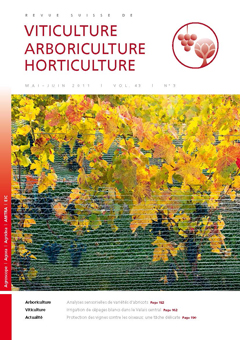
Issue 3 - May - June 2011
Abstract in open access
The goal of this project was to assess the sensory characteristics of new ACW obtained apricot hybrids and of different clones of ´Luizet´ in order to compare them to international cultivars. A group of panelist was trained to develop a quantitative descriptive profile using eleven sensory attributes generated during the training sessions. The results showed that the attributes ´Firmness´, ´Herbaceous Odor´, ´Juiciness´, ´Crunchiness´, ´Acidity´, ´Sweetness´, ´Astringency´ and ´Apricot Aroma´ allowed an accurate discrimination of the cultivars. A Principal Component Analysis (PCA) revealed high variability between cultivars for attributes related with fruit ripening (e.g. ´Firmness´, ´Acidity´, ´Sweetness´ or ´Apricot Aroma´). These sensory analyses allow to position the new ACW hybrids against international cultivars. Furthermore, only weak differences were found between the clones of ´Luizet´.
Keywords: sensory evaluation, apricots, hybrids, ´Luizet´ clones
E-Mail: danilo.christen@acw.admin.ch
Adress:
Abstract in open access
Several irrigation treatments were conducted in Leytron (central Valais) on an homogeneous plantation of white grape cultivars Chasselas, Sylvaner et Arvine. Moderated water restriction led to a better accumulation of residual sugars in the berries. However, a strong and consistent water stress led to a decrease in the gaseous exchanges as well as to lower concentrations of residual sugars in the must. Malic acid and potassium rates in the must were lower when grapevines were not irrigated, while tartaric acid in the wine rate was higher under the same conditions. Sylvaner and Arvine wines had less bouquet and were bitterer when cultivars suffered without irrigation from a strong water restriction, but also sometimes from moderated water restriction.
Keywords: irrigation, water stress, plant behaviour, wine quality.
E-Mail: jean-laurent.spring@acw.admin.ch
Adress:
Abstract in open access
To save energy in greenhouses, the use of a thermal screen is helpful during the night but also during the day. Two trials were conducted in 2009 and 2010 in two identical compartments, each of 358 m2. Both were equipped with a thermal screen (SLS 10 Ultra Plus) and an aluminized screen (XLS 15) made by Svensson. In the test compartment, screens were opened differentially. The aluminized screen opened half an hour after sunrise while thermal screen opened one hour after sunrise, but only when the outside temperature was above 5 °C and light intensity higher than 3 klux; otherwise it remained closed. In the control compartment, the opening of the screens occurred at sunrise. Differentiated screen management resulted in an energy saving of 23 % in 2009 and 30 % in 2010 without negative impact on yield and analytical quality of tomatoes. The incidence of grey mould (Botrytis cinerea) was not affected by this management. These results confirm that differentiated screen management is a simple way to save energy in greenhouse tomato production.
Keywords: thermal screen, energy saving, tomato, glasshouse.
E-Mail: cedric.camps@agrocope.admin.ch
Adress:
Abstract in open access
All stakeholders, from consumers to regulators are focusing their demand on reducing the environmental impact of viticulture, but not at the expense of the quality of the wine. After presenting these impacts, the authors expose the Life Cycle Assessment method. They propose an approach to adapt the method for assessing environmental impacts in Loire Valley PDO viticulture, to evaluate compatibility between qualitative and environmental objectives in wine grapes production. The limits of the system considered are explained and the choice of functional unit and its importance in viticultural context are discussed.
Keywords: environmental evaluation, viticulture, LCA, functional unit
E-Mail: c.renaud@groupe-esa.com
Adress: Ecole supérieure d'agriculture d'Angers ESA, F-49007 Angers Cedex 01

 Download of full issue
Download of full issue
 Download article
Download article